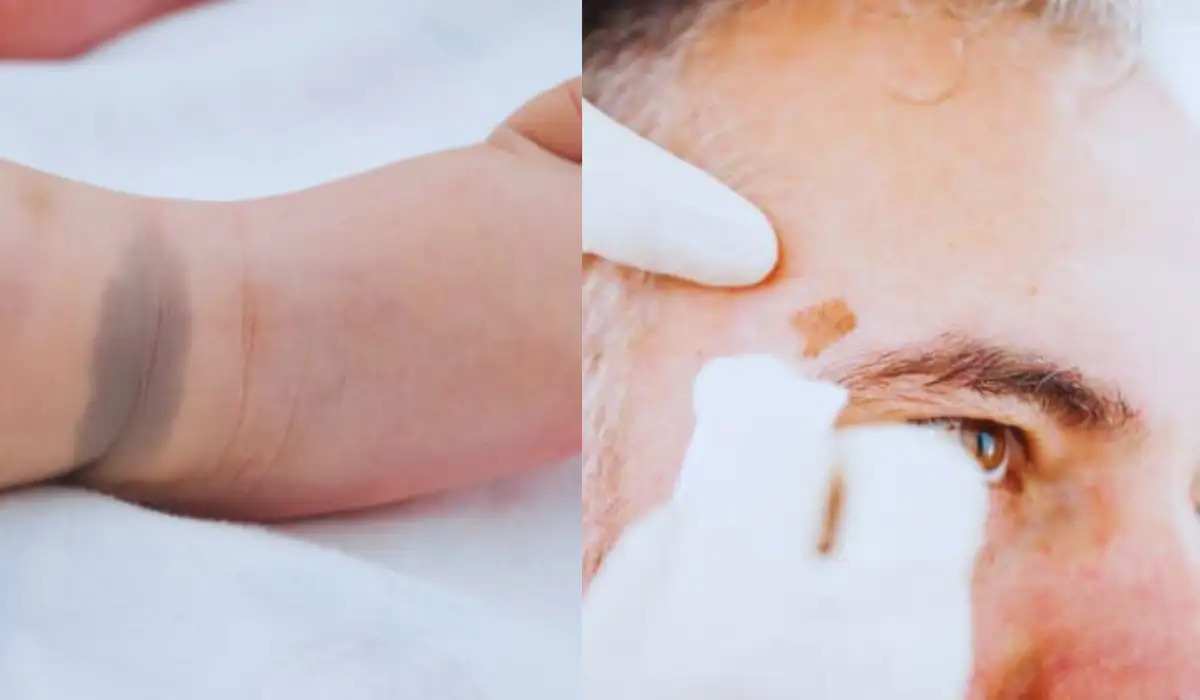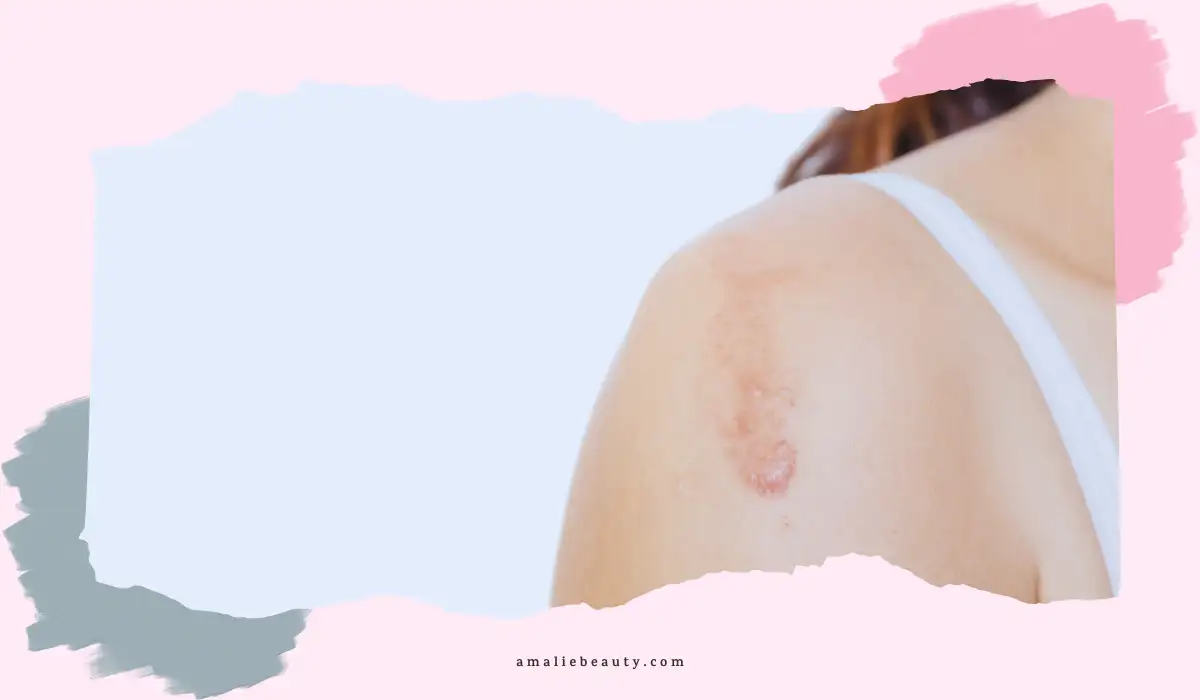Birthmarks are areas of discolored skin. They are present at the time of birth or develop shortly after birth. They are incredibly common, occurring in up to 80% of infants.
While often harmless, some birthmarks require medical treatment for health or cosmetic reasons. This article gives an outline of the most common types of birthmarks and covers what causes them and if they run into families.
Further, it will also cover cosmetic issues, the risk of cancer, and when treatment may be needed.
Birthmarks may startle at first. But, most of them pose no medical concern. However, it is still essential to understand the birthmark categories.
They help us see if monitoring or intervention may be needed. Discussing your child’s birthmarks with a pediatrician is vital. It helps catch rare marks that could show syndromes or disorders. Together, you can make a treatment plan. It will focus on health first and, if desired, on looks.
What Are The Types of Birthmarks?

➡️ Vascular Birthmarks
The most common birthmark type is vascular. Abnormal blood vessels cause it. The blood vessels form during fetal development, in or under the skin. There are several subtypes:
- Salmon Patches: Salmon Patches are very common. They are pink or red flat marks on the forehead, eyelids, back of the neck, or upper lip. They generally fade by age 2. No treatment is needed.
- Port Wine Stains: These red or purple marks happen due to dilated capillaries. They start flat but can thicken over time. Laser therapy is sometimes prescribed for cosmetic reasons or to prevent thickening.
- Hemangiomas: Raised, red benign tumors filled with blood vessels. Some disappear by age 10, others may need treatment to prevent complications.
➡️ Pigmented Birthmarks
Vascular marks are filled with blood vessels. But, pigmented birthmarks come from clusters of pigment cells (melanocytes) or moles. They are present at birth. Common types are:
- Cafe-Au-Lait Spots: Light tan, coffee-colored marks that can fade by age 12. No treatment is needed unless there are more than 6 spots. More spots may indicate a disorder.
- Mongolian Spots: Bluish gray marks on lower back/buttocks. Usually disappear by school-age years. No intervention is needed.
- Nevus Sebaceous: Yellowish patchy marks, often on the scalp or face. May be present at birth time or develop in early childhood stages. Usually non-cancerous unless changes are observed.
Causes & Genetics of Birthmarks
In most cases, the cause of birthmarks remains unknown. They are not hereditary or related to anything the mother did during pregnancy. However, some clues into how different types develop exist:
- Vascular birthmarks form due to the failed migration of cells that create blood vessels into their proper location.
- Pigmented marks, like cafe-au-lait spots, come from melanocytes getting stuck. They got stuck as they moved down from the neural crest during fetal development.
- Hemangiomas likely start from cells multiplying too rapidly in circumscribed areas.
These syndromes are not genetic. But they have birthmarks plus added symptoms. They include PHACE, Klippel-Trenaunay, and Sturge-Weber syndrome.
No Birthmarks?
Since the majority of babies have some type of birthmark, it is normal for parents to be concerned if none are seen initially at birth.
However, some birthmarks can develop weeks or months later, so continued monitoring of the skin is recommended. Mongolian spots, in particular, often do not appear until several months of age.
By one year old, around 20% of babies still have no visible birthmarks. There’s typically no cause for concern if the child is otherwise meeting developmental milestones.
Very rarely, lack of markings indicates an underlying mutation in genes responsible for vascular development. Additional genetic testing would be warranted in that scenario.
Are Birthmarks Pose A Cancer Risk?
Most birthmarks pose no cancer risk. They stay benign and don’t change. An exception is congenital moles. They have a slightly higher lifetime risk for melanoma.
Moles present at birth tend to be larger (>6mm) with irregular borders and may have multiple colors.
All moles, including benign ones, should be checked often for the ABCDE signs of melanoma. These signs are asymmetry, irregular borders, color changes, diameter increases, and evolving appearance.
Any sudden changes in a mole’s size, shape, or color require an urgent visit to the dermatologist. The dermatologist will examine it with a dermoscope.
Outside of moles, other birthmarks like hemangiomas very rarely transform into cancers. Some birthmarks may indicate a syndrome with higher cancer risk later in life, like PHACE. In those cases, other screenings and monitoring would be done. They are part of syndrome management.
Treatment for Cosmetic Reasons
Most birthmarks cause no medical issues. So, parents make treatment decisions based on their cosmetic preferences. They also consider the child’s social and emotional needs.
Families seek treatment for common reasons. These include markings on visible areas, like the face. They also include growing lesions that block vision or normal functioning. Thankfully there are various effective options:
- Laser Therapy: Successfully fades or removes pigmented lesions and superficial vascular marks. Often, requires multiple sessions.
- Deeper hemangiomas or raised vascular growths may need surgery. It is especially true if they press on vital structures.
- Medications can help. Topical drugs and oral propranolol can curb the growth and swelling of hemangiomas.
- Cosmetics: Dermatologist-recommended makeup products can temporarily mask birthmarks. Generally recommended for ages 10+ when self-consciousness often develops.
Psychosocial Effects
Visible birthmarks can elicit intrusive comments and stares from strangers. As such, children may feel shame and embarrassment. It is especially true for school-aged kids concerned about appearing “different.”
Young girls tend to report more distress regarding facial birthmarks. Without proper emotional support, this can negatively impact self-esteem and feed anxiety during formative years.
All birthmarks can cause distress. The amount depends on how visible they are and on society’s views on beauty. But, according to research, vascular lesions cause more psychosocial harm.
This is why healthcare providers stress early counsel and treatments for face port wine stains. They do this more than for harmless marks elsewhere.
Conclusion
Birthmarks arise from cellular and pigment irregularities forming before birth or shortly after. Common types include moles, pigmented lesions, salmon patches, hemangiomas, and port wine stains.
Texture also aids classification, with marks presenting as flat or raised. The cause is often unknown. But, genetics and hereditary disorders play a role in some, especially vascular markings. However, most appear at random.
The majority of birthmarks cause no health issues and tend to fade over time. Treatment is usually unnecessary, as many resolve on their own. However, laser therapy can effectively lighten pigmented lesions.
Dermabrasion and surgery provide additional options for minimizing appearance. Removal is primarily performed for cosmetic reasons if the mark is bothersome to the individual.
In summary, parents need not worry about most baby birthmarks. Beyond appearances, some people view them as distinguishing characteristics to be proud of.
Monitoring markings for any evolving asymmetry, irregularities, color changes, or bleeding is wise, though. Bringing worrying changes to the attention of one’s doctor is recommended, whether a birthmark or not. Thankfully, the outlook for leading birthmark skin cancers is positive when detected and managed early.
References
- NIH. (2009). Multiple café-au-lait spots.
https://rarediseases.info.nih.gov/diseases/3967/multiple-cafe-au-lait-spots - Laquer VT, et al. (2013). Microarray analysis of port-wine stains before and after pulsed dye laser treatment.
https://doi.org/10.1002/lsm.22087

